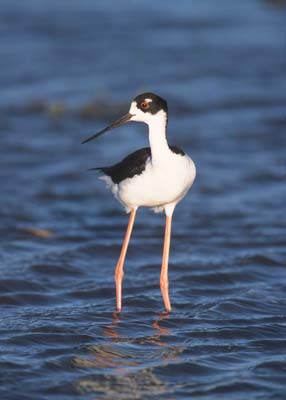Imperiled species thrive at Pearl Harbor

New management efforts boost the ponds' population of endangered species.
What began as a handful of wetland ponds with dozens of birds overlooking Pearl Harbor has turned into a refuge teeming with hundreds.
The number of native birds, including endangered Hawaiian stilts called ae o, in the ponds at Waiawa and Honouliuli at the Pearl Harbor National Wildlife Refuge has been rising since the early 1990s, when a conservation recovery plan was developed, said David Ellis, refuge project leader.
Federal wildlife officials built fences to help keep out predators and began controlling invasive plants and managing water in the ponds.
"There’s been a very noticeable increase," Ellis said. "There used to be only a few wetland birds that used these ponds ; now we commonly see hundreds, an important step for endangered species."
Under a revised conservation plan completed late last year, officials plan to increase management efforts on the 25-acre refuge at Waiawa as well as refuge areas at Honouliuli near the harbor’s Middle Loch and Kalaeloa at Barbers Point.
The refuge was created at Waiawa and Honouliuli in the 1970s to provide alternative wetland sites for endangered and native wetland birds due to areas destroyed by the development of Honolulu Airport’s Reef Runway.
Don't miss out on what's happening!
Stay in touch with breaking news, as it happens, conveniently in your email inbox. It's FREE!
The 37-acre Kalaeloa Unit was added to the refuge after the closing of Barbers Point Naval Air Station. This area protects endangered and rare native coastal plants.
Waiawa and Honouliuli remain an important part of the refuge on Oahu for endangered stilts as well as other endangered Hawaiian birds including coots, ducks and moorhens.
"These protected areas are vital to the recovery of these endangered species," Ellis said.
The refuge is also the site of community involvement, where Leeward Community College students and other volunteers remove non-native weeds from the Kalaeloa Unit and more than 2,000 third-grade students learn about the recovery of water birds and the value of the wetlands on the Honouliuli Unit during field trips each year.
At Kalaeloa, rare anchialine pools are home to native shrimp, including one rare species that is a candidate for the endangered species list.
U.S Fish and Wildlife Service biologists are also planning to make Kalaeloa the host to the native damselfly, or pinapinao, whose numbers have been decreasing, and to develop a formal foot-trail system.
Ellis said the development of the trail has no hard deadline, because volunteers are contributing their labor for the project.
Visits to the refuge can be organized in conjunction with an established volunteer project. To volunteer, call 637-6330.



